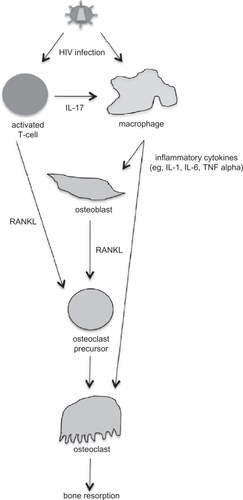Figures & data
Table 1 General risk factors associated with human immunodeficiency virus infection to bone mineral density loss
Figure 1 Proposed model for how human immunodeficiency virus (HIV) infection is associated with bone mineral density loss. HIV can infect both activated T cells and macrophages. HIV-infected T cells express interleukin (IL)-17, which stimulates HIV-infected macrophages to produce inflammatory cytokines, including IL-1, IL-6, and tumor necrosis factor (TNF). The inflammatory cytokines can stimulate both osteoblasts and osteoclasts. HIV-infected activated T cells and osteoblasts produce RANKL, which further stimulates osteoclastogenesis. Overproduction of osteoclast activity results in an imbalance in bone remodeling and increases bone resorption.

Table 2 Drug classes in highly active antiretroviral therapy that have been implicated as risk factors for bone mineral density